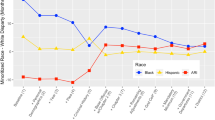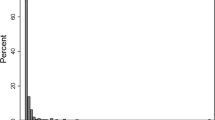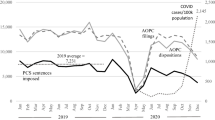Abstract
Over the last several decades, federal courts have devoted considerable effort towards improving fairness in sentencing. Despite these efforts, research has consistently shown that racial/ethnic minority defendants receive harsher sentences than similarly situated White defendants. While a large body of research has detected these racial/ethnic disparities, relatively few studies have examined how they have changed over time in light of the different legal, societal, and priority changes in federal criminal courts (and the United States more broadly). Using 22 years of federal sentencing data, the current study assesses trends in Black-White and Hispanic-White sentencing disparities (net of factors relevant to sentencing). Results suggest that trends in racial/ethnic sentencing disparities differ by the dependent variable examined. At incarceration, Black and Hispanic disadvantages have been largely time stable. However, racial/ethnic effects on sentence length have changed over time, diminishing in early years before re-aggravating in later years. Findings suggest that the movement towards racial/ethnic equity in sentencing has been slower than many might hope, with setbacks along the way. The re-emergence of racial/ethnic disadvantages indicates the need for a renewed focus towards reducing racial/ethnic disparities and creating greater egalitarianism in sentencing.



Similar content being viewed by others
Notes
This is referred to as the pre-PROTECT Act in their study. For parsimony with our point, however, we refer to it as the “pre-pre-Booker era.” The USSC’s 2017 report also includes this “pre-pre-Booker” era. However, similar to the discussion in the text, Ulmer et al. (2011) find relative stability while the 2017 USSC report finds aggravation.
Immigration defendants are systemically different from the average federal defendant (more likely to be Hispanic, possess systemically lower levels of education, and close to 90% non-citizen; see Hartley & Tillyer, 2012).
We tried to use multiple imputation for the full, about 1 million observation, dataset but it wouldn’t converge. Thus, as a robustness check we used multiple imputation for several year-specific models. The results were identical.
Data on district-level predictors were not available each year. When an upper and lower bound existed we filled in missing years using linear interpolation. Alternatively, when an upper and lower bound did not exist, we utilized 5-year rates of change following the last available estimate. Sensitivity tests were run and the decision to interpolate/extrapolate missing district-level data had no discernable impact on racial/ethnic effects or trends.
We recognize there is some debate surrounding whether presumptive sentence is endogenous to the final sentencing decision (see Starr & Rehavi, 2013). To be conservative (see Light, 2022), we use presumptive sentence in our estimates of racial/ethnic effects (for similar practices see Kim et al., 2019; Ulmer & Parker, 2020). Models using additive controls for offense severity and criminal history were ran and they provided larger in magnitude, but similar in trends, racial/ethnic effects – like we would expect.
Some studies include judge-initiated (upward and downward) departures as predictors (Ulmer et al., 2011; USSC, 2012). However, this approach has been critiqued because judge-initiated departures occur simultaneous to the final sentencing decision (see Starr & Rehavi, 2013). Our main models include a control for government-sponsored departure but not judge initiated departures (see Fischman & Schanzenbach, 2012; Ulmer & Parker, 2020). Models including the full set of departure controls were estimated, and the racial/ethnic trends were identical. We also ran supplemental models with mandatory minimum eligibility as a control variable, and the results were substantively identical to those presented here.
Due to the scope of the analysis, we omit a lengthy discussion of descriptive statistics. However, a table of descriptive statistics is available for reference in Appendix A.
The utility of multi-level models has been well established in past federal sentencing research (Johnson et al., 2008; Kim et al., 2019; Light, 2014; Ulmer et al., 2011). In the context of this study, the multi-level models adjust the degrees of freedom at higher levels of analysis to the appropriate sample size and account for the dependency of cases within districts (Byrk & Raudenbush, 1992).
Unconditional models show significant variance in both incarceration and sentence length at the case- and district-level. In the sentence length models (where it is meaningful to estimate interclass correlations), 95% of variance lies at the case-level and 5% of variance lies at the district-level.
We do not include the Heckman (1976) correction term in our sentence length models due to substantive collinearity between the inverse mills ratio and both guideline minimum and presentence detention (for similar concerns surrounding the Heckman correction see Bushway et al., 2007). Supplemental models with the Heckman correction term were estimated and the results were substantively similar to those presented.
District-level controls in these models represent the average over the study period.
These raw sentence length trends partitioned by defendant race/ethnicity and drug cases are available upon request.
References
Alexander, M. (2010). The new Jim Crow: Mass incarceration in the age of colorblindness. The New Press.
Allport, G. W. (1954). The Nature of Prejudice. Addison-Wesley.
Baumer, E. P. (2013). Reassessing and redirecting research on race and sentencing. Justice Quarterly, 30, 231–261.
Berk, R. B. (2010). What you can and can’t properly do with regression. Journal of Quantitative Criminology, 26, 481–487.
Blalock, H. M. Jr. (1967). Toward a theory of minority group relations. New York, NY: Capricorn Books
Blume, W. W., & Brown, E. G. (1962). Territorial courts and law: Unifying factors in the development of American legal institutions: Part I. establishment of a standardized judicial system. Michigan Law Review, 61, 39–106.
Blumer, H. (1958). Race prejudice as a sense of group position. Pacific Sociological Review, 23, 3–7.
Bobo, L. D., Charles, C. Z., Krysan, M., & Simmons, A. D. (2012). The real record of racial attitudes. In Marsden, Peter V. (Ed.), Social trends in American life: Findings from the general social survey since 1972. Princeton, NJ: Princeton University Press. https://scholar.harvard.edu/files/bobo/files/2012_real_record_on_racial_attitudes_social_trends_in_american_life_0.pdf
Bushway, S. D., & Forst, B. (2013). Studying discretion in the processes that generate criminal justice sanctions. Justice Quarterly, 30, 199–222.
Bushway, S. D., Johnson, B. D., & Slocum, L. A. (2007). Is the magic still there? The relevance of the Heckman two-step correction for selection bias in criminology. Journal of Quantitative Criminology, 23, 151–178.
Byrk, A., & Raudenbush, S. (1992). Hierarchical linear models for social and behavioral research: Applications and data analysis methods. Sage.
Chomsky, A. (2014). Undocumented: How immigration became illegal. Boston, MA: Beacon Press.
Chomsky, A. (2018). “They take our jobs!” and 20 other myths about immigration. Boston, MA: Beacon Press.
Doerner, J. K., & Demuth, S. (2010). The independent and joint effects of race/ethnicity, gender, and age on sentencing outcomes in U.S. federal courts. Justice Quarterly, 27, 1–27.
Doerner, J. K., & Demuth, S. (2014). Gender and sentencing in federal courts: Are women treated more leniently? Criminal Justice Policy Review, 25, 242–269.
Doyle, C. (2018). Juvenile Delinquents and Federal Criminal Law: The Federal Juvenile Delinquency Act and Related Matters. Congressional Research Service, Library of Congress.
Economic Cycle Research Institute. (2016). U.S. Cyclical Outlook Essentials. New York, NY: Economic Cycle Research Institute.
Eisenstein, J., Flemming, R., & Nardulli, P. (1988). The contours of justice: Communities and their courts. Little, Brown.
Fair Sentencing Act of. (2010). 111–220, 124 Stat. 2372, S.1789, enacted August 3, 2010.
Feldmeyer, B., & Ulmer, J. T. (2011). Racial/ethnic threat and federal sentencing. Journal of Research in Crime and Delinquency, 48, 238–270.
Feldmeyer, B., Warren, P. Y., Siennick, S. E., & Neptune, M. (2015). Racial, ethnic, and immigrant threat: Is there a new criminal threat on state sentencing? Journal of Research in Crime and Delinquency, 52, 62–92.
Fischman, J. B., & Schanzenbach, M. M. (2012). Racial disparities under the federal sentencing guidelines: The role of judicial discretion and mandatory minimums. Journal of Empirical Legal Studies, 9, 729–764.
Gall v. United States, 552 U.S. 38 (2007).
Gonzales, A. (2005). Federal sentencing guidelines speech by Attorney General Alberto Gonzales. Federal Sentencing Reporter, 17, 324.
Hartley, R. D., & Tillyer, R. (2012). Defending the homeland: Judicial sentencing practices for federal immigration offenses. Justice Quarterly, 29, 76–104.
Heckman, J. J. (1976). The common structure of statistical models of truncation, sample selection, and limited dependent variables. Annals of Economic and Social Measurement, 5, 475–492.
Hofer, P. J. (2019). Federal sentencing after booker. Crime and Justice, 48, 137–186.
Holder, E. (2010). Memorandum to All Federal Prosecutors: Department Policy on Charging and Sentencing. Office of the Attorney General.
Holmes, B., & Feldmeyer, B. (2019). Reassessing the influence of criminal history in federal criminal courts. Justice Quarterly, 36, 1206–1228.
Igielnik, R., & Budiman, A. (2020). The Changing Racial and Ethnic Composition of the U.S. Electorate. Pew Research Center.
Johnson, B. D., Spohn, C., & Kimchi, A. (2021). Life lessons: Examining sources of racial and ethnic disparity in federal life without parole sentences. Criminology, 1–34. https://doi.org/10.1111/1745-9125.12288.
Johnson, B. D., Ulmer, J. T., & Kramer, J. H. (2008). The social context of guideline circumvention: The case of federal district courts. Criminology, 46, 711–783.
Kautt, P. M. (2002). Location, location, location: Interdistrict and intercircuit variation in sentencing outcomes for federal drug-trafficking offenses. Justice Quarterly, 19, 633–671.
Kim, B., Cano, M. V., Kim, K., & Spohn, C. C. (2016). The Impact of United States v. Booker and Gall/Kimbrough v. United States on Sentence Severity: Assessing social context and judicial discretion. Crime & Delinquency, 62, 1072–1094.
Kim, B., Wang, X., & Cheon, H. (2019). Examining the impact of ecological contexts on gender disparity in federal sentencing. Justice Quarterly, 36, 466–502.
King, R. D., & Light, M. T. (2019). Have Racial and Ethnic Disparities in Sentencing Declined? Crime and Justice, 48, 365–437.
Koo, D., Feldmeyer, B., & Holmes, B. (2022). Citizenship and sentencing: Assessing intersectionality in national origin and legal migration status on federal sentencing outcomes. Journal of Research in Crime and Delinquency, 59, 203–239.
Koon v. United States, 518 U.S. 81 (1996).
Levitt, S. D. (2004). Understanding why crime fell in the 1990s: Four factors that explain the decline and six that do not. Journal of Economic Perspectives, 18, 163–190.
Light, M. T. (2014). The new face of legal inequality: Noncitizens and the long-term trends in sentencing disparities across US district courts, 1992–2009. Law & Society Review, 48, 447–478.
Light, M. T. (2022). The declining significance of race in criminal sentencing: Evidence from US federal courts. Social Forces, 100, 1110–1141.
Light, M. T., Dinsmore, E., & Massoglia, M. (2019). How do criminal courts respond in times of crisis? Evidence from 9/11. American Journal of Sociology, 125, 485–533.
Lynch, M. (2016). Hard bargains: The coercive power of drug laws in federal court. Russell Sage Foundation.
Lynch, M. (2019). Focally concerned about focal concerns: A conceptual and methodological critique of sentencing disparities research. Justice Quarterly, 36, 1148–1175.
Lynch, M., Barno, M., & Omori, M. (2021). Prosecutors, court communities, and policy change: The impact of internal DOJ reforms on federal prosecutorial practices. Criminology, 59, 480–519.
Lynch, M., & Omori, M. (2014). Legal change and sentencing norms in the wake of Booker: The impact of time and place on drug trafficking cases in federal court. Law & Society Review, 48, 411–445.
Migration Policy Institute. (2019). Migration Data Hub: U.S. Immigration Trends. Washington, DC: Migration Policy Institute.
Mitchell, O. (2005). A meta-analysis of race and sentencing literature: Explaining the inconsistencies. Journal of Quantitative Criminology, 21, 439–466.
Nowacki, J. S. (2017). An intersectional approach to race/ethnicity, sex, and age disparity in federal sentencing outcomes: An examination of policy across time periods. Criminology & Criminal Justice, 17, 97–116.
Ousey, G. C., & Kubrin, C. E. (2009). Exploring the connection between immigration and violent crime rates in US cities, 1980–2000. Social Problems, 56, 447–473.
Parker, L., Horowitz, J., & Mahl, B. (2016). On Views of Race and Inequality: Blacks and Whites are Worlds Apart. Pew Research Center.
Prosecutorial Remedies and Other Tools to End the Exploitation of Children Today (PROTECT) Act of 2003. Pub. L. No. 108-21 (2003). https://www.congress.gov/108/plaws/publ21/PLAW-108publ21.pdf
Schuman, H., Steeh, C., Bobo, L. D., & Krysan, M. (1997). Racial Attitudes in America: Trends and Interpretations (2nd ed.). Harvard University Press.
Spohn, C. (2000). Thirty years of sentencing reform: The quest for a racially neutral sentencing process. Criminal Justice, 3, 427–501.
Starr, S. B., & Rehavi, M. M. (2013). Mandatory sentencing and racial disparity: Assessing the role of prosecutors and the effects of Booker. The Yale Law Journal, 123, 2–80.
Steffensmeier, D., Ulmer, J. T., & Kramer, J. H. (1998). The interaction of race, gender, and age in criminal sentencing: The punishment cost of being young, black, and male. Criminology, 36, 763–798.
Steffensmeier, D., Painter-Davis, N., & Ulmer, J. T. (2017). Intersectionality of race, ethnicity, gender, and age on criminal punishment. Soc Perspectives, 60, 810–833.
Stults, B., & Swagar, N. (2018). Racial and ethnic threat: Theory, research and new directions. In Martinez, Ramiro, Hollins, Meghan E., Stowell, Jacob I. (Eds.), The Handbook of Race, Ethnicity, Crime, and Justice. Wiley-Blackwell.
Stumpf, J. (2006). The crimmigation crisis: Immigrants, crime, and sovereign power. American University Law Review, 56, 367–420.
Tonry, M. (2015). Federal sentencing “reform” since 1984: The awful as enemy of the good. Crime and Justice, 44, 99–164.
Ulmer, J. T. (2000). The rules have changed-so proceed with caution: A comment on Engen and Gainey’s method for modeling sentencing outcomes under guidelines. Criminology, 38, 1231–1243.
Ulmer, J. T. (2019). Criminal courts as inhabited institutions: Making sense of difference and similarity in sentencing. Crime and Justice, 48, 483–522.
Ulmer, J. T., Eisenstein, J., & Johnson, B. D. (2010). Trial penalties in federal sentencing: Extra-guideline factors and district variation. Justice Quarterly, 27, 560–592.
Ulmer, J. T., Light, M. T., & Kramer, J. H. (2011). Racial disparity in the wake of the Booker/FanFan decision: An alternative analysis to the USSC’s 2010 report. Criminology & Public Policy, 10, 1077–1118.
Ulmer, J. T., & Parker, B. R. (2020). Federal sentencing of Hispanic defendants in changing immigrant populations. Justice Quarterly, 37, 541–570.
United States Census Bureau. (1980). Decennial Census of Population and Housing. United States Census Bureau.
United States Census Bureau. (2020). Decennial Census of Population and Housing. United States Census Bureau.
United States Sentencing Commission. (1995). Special Report to Congress: Cocaine and Federal Sentencing Policy. Office of General Counsel United States Sentencing Commission.
United States Sentencing Commission. (1997). Special Report to Congress: Cocaine and Federal Sentencing Policy. Office of General Counsel United States Sentencing Commission.
United States Sentencing Commission. (2002). Special Report to Congress: Cocaine and Federal Sentencing Policy. Office of General Counsel United States Sentencing Commission.
United States Sentencing Commission. (2006). Final Report on the impact of United States v. Booker on federal sentencing. Office of General Counsel United States Sentencing Commission.
United States Sentencing Commission. (2007). Special Report to Congress: Cocaine and Federal Sentencing Policy. Office of General Counsel United States Sentencing Commission.
United States Sentencing Commission. (2010). Demographic Differences in Federal Sentencing Practices: An Update of the Booker Report’s Multivariate Regression Analysis. Office of General Counsel United States Sentencing Commission.
United States Sentencing Commission. (2012). Report on the Continuing Impact of United States v. Booker on Federal Sentencing. Office of General Counsel United States Sentencing Commission.
United States Sentencing Commission. (2015). Report to the Congress: Impact of the Fair Sentencing Act of 2010. Office of General Counsel United States Sentencing Commission.
United States Sentencing Commission. (2017). Demographic Differences in Sentencing: An Update to the 2012 Booker Report. Office of General Counsel United States Sentencing Commission.
United States v. Booker, 543 U.S. 220 (2005).
Ulmer, J. T. (2012). Recent developments and new directions in sentencing research. Justice Quarterly, 29, 1–40.
Yang, C. S. (2015). Free at last? Judicial discretion and racial disparities in federal sentencing. The Journal of Legal Studies, 44(1), 75–111.
Zatz, M. S. (1987). The changing forms of racial/ethnic biases in sentencing. Journal of Research in Crime and Delinquency, 24, 69–92.
Zatz, M. S., & Smith, H. (2012). Immigration, crime, and victimization: Rhetoric and reality. Annual Review of Law and Social Science, 8, 141–159.
Funding
Funding for this research was received from the National Institute of Justice [2020-R2-CX-0016].
Author information
Authors and Affiliations
Corresponding author
Ethics declarations
Conflict of Interests
The authors have no relevant financial or non-financial interests to disclose.
Additional information
Publisher's Note
Springer Nature remains neutral with regard to jurisdictional claims in published maps and institutional affiliations.
Supplementary Information
Below is the link to the electronic supplementary material.
Rights and permissions
Springer Nature or its licensor (e.g. a society or other partner) holds exclusive rights to this article under a publishing agreement with the author(s) or other rightsholder(s); author self-archiving of the accepted manuscript version of this article is solely governed by the terms of such publishing agreement and applicable law.
About this article
Cite this article
Holmes, B., Feldmeyer, B. The Only Thing Constant is Change: Temporal Analyses of Racial/Ethnic Sentencing Disparities. Am J Crim Just 48, 1080–1104 (2023). https://doi.org/10.1007/s12103-023-09725-9
Received:
Accepted:
Published:
Issue Date:
DOI: https://doi.org/10.1007/s12103-023-09725-9




